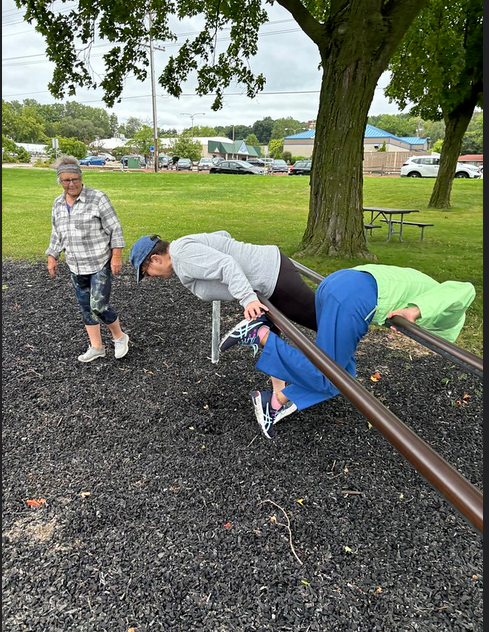What If We Required Physical Inactivity Waivers?
- Erin Eleu
- May 31
- 3 min read

“If you’re going to participate in any kind of physical activity, you must fill out a waiver!”
That’s what participants were told as they entered the line dancing session at a recent Senior Summit event. As fitness professionals and physical activity leaders, we’re used to hearing this. We understand the legal necessity behind these waivers. They’re there to protect organizations and individuals in case of injury and they send a clear message:
"Physical activity is risky. You might hurt yourself."
Waiver language can read something like:
“I understand that physical exercise, including the use of equipment and machinery, is potentially hazardous and carries with it risks of physical injury or illness, including but not limited to minor injuries, sprains, strains, severe injuries, heart attacks, and death.”
While it's true that physical activity carries some risk, what’s not stated anywhere in these forms is the risk of doing nothing.
What If We Also Required a Waiver for Inactivity?
What if before opting out of a class, a walk, or a movement session, participants were asked to read and sign a Physical Inactivity Waiver.
It might look something like this:
Risks of Physical Inactivity
I acknowledge that choosing not to engage in regular physical activity may increase the risk of developing or worsening a number of health conditions. These may include, but are not limited to:
Cardiovascular disease
Type 2 diabetes and metabolic syndrome
Musculoskeletal issues such as loss of muscle strength, poor balance, joint stiffness, and decreased bone density
Mental health conditions including anxiety and depression
Cognitive decline and increased risk of dementia
Reduced immune function and overall vitality
Increased risk of falls and physical injury due to deconditioning
I understand that a sedentary lifestyle may negatively impact my overall health, independence, and quality of life. I acknowledge the importance of regular, safe, and appropriate physical activity in reducing these risks.
Of course, no one is handing these out at the door. But maybe they should.
Balancing the Message: Risks and Benefits of Both Sides
It’s important to note that both physical activity and inactivity come with a set of tradeoffs. If we’re going to talk about risks, let’s also talk about the potential positive outcomes on either side.
The Upside of Physical Activity
While physical activity carries inherent risk, it also brings significant benefits:
Improved cardiovascular health and blood pressure regulation
Better metabolic function
Increased strength, mobility, and balance
Reduced risk of chronic disease and falls
Improved mood, reduced anxiety and depression
Sharper cognitive function and reduced dementia risk
Social connection, confidence, and independence
These are powerful outcomes. And they’re often overlooked in favor of simply “avoiding injury.”
The (Perceived) Upside of Inactivity
It’s also fair to acknowledge the “positive” side of inactivity, at least in the short term. Many people avoid physical activity for reasons that feel valid, such as:
Comfort and convenience
Avoiding physical discomfort, pain, or exertion
Saving time and effort by using assistive tools, vehicles, or technology
Maintaining familiar routines or minimizing perceived risk
Fear of embarrassment, injury, or being judged
These benefits are often emotional or logistical, not physiological. But they’re real to the individual. Understanding these motivations allows us to meet people where they are and invite them into movement in a way that feels safe, supportive, and realistic.
It’s Not About Fear—It’s About Informed Choice
Fear isn't an effective long-term motivator. Neither activity nor inactivity waivers should be designed to scare people into compliance. But we do need to tell the whole story.
There’s a cultural bias toward inactivity as the “safe default” as if doing nothing somehow carries less risk than taking action. But science tells a different story. Physical inactivity is a contributor to chronic disease, diminished independence, and physical decline.
All of Life Has Risk—So What Are You Choosing?
There’s risk in everything:
Driving a car
Walking a dog
Reaching for a can on the top shelf
What we don’t talk about enough is the risk of doing nothing.
If we are advocating for the health and wellness, we must understand and reduce the barriers to physical activity making it accessible, approachable, and enjoyable for everyone.
When fear overshadows movement, we risk discouraging people from taking even the first step.
For anyone invested in advocating for health and wellness, it’s time to reflect: are we unintentionally creating barriers by overemphasizing risk? Are we balancing our responsibility to inform with our responsibility to inspire?
Let’s ensure that in our efforts to protect, we don’t inadvertently prevent. Movement is a lifeline, not a liability.




Comments